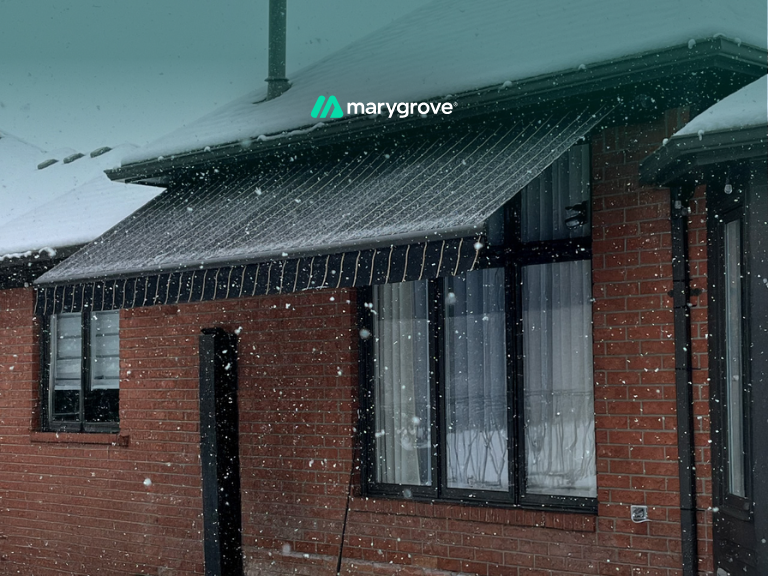To winterize a retractable awning, clean and dry the fabric, inspect hardware, lubricate joints, retract during harsh weather, cover it with a breathable shield, unplug the motor, and protect it from snow and wind exposure.
Winter-Proof Your Awning with These Simple Precautions
Winter weather can wear down even the best-built awnings, unless you prepare them right. From freezing motors to moldy fabric, cold conditions bring risks that often go unnoticed until spring.
But with a few habits, your awning can survive the season without a scratch. Here’s what winterizing looks like in practical terms:
- Inspect for rust, tears, or loose bolts before freezing temps hit.
- Lubricate moving parts with silicone spray to prevent freezing.
- Retract the awning during storms, frost, or snow.
- Unplug or lock motorized controls to avoid accidental damage.
- Clear snow and manage wind exposure throughout the season.
- Remove Valance and store away for next season.
You don’t need to give up using your awning entirely, just use it smartly.
Mild, dry days still offer a chance to enjoy shade or shelter, and with protective steps in place, you won’t be left with surprises when spring rolls around.
Stick with us till the end and you’ll not only avoid common mistakes, you’ll walk away knowing exactly how to winter-proof your awning like a pro.
What Is Awning Winterization and Why It Matters
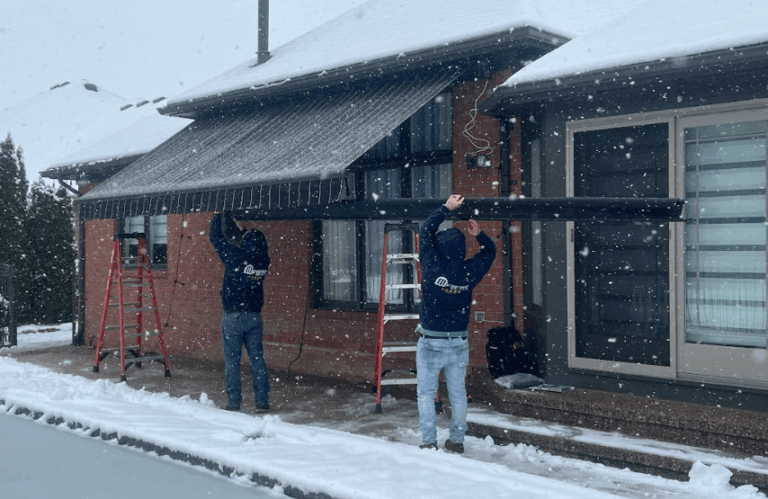
Winterizing your retractable awning means taking simple steps to protect it from cold, snow, wind, and moisture.
It’s not about shutting it down, it’s about keeping it safe during harsh conditions while still enjoying it when the weather allows.
Why Winter Can Be Hard on Awnings
Cold weather brings a different kind of stress to retractable awnings, stress that’s easy to overlook until something fails.
Here are the main factors that make winter tougher on your system:
- Cold Can Freeze Motors: When temperatures drop below freezing, motors and joints can seize up. Trying to open the awning in this condition can damage the system.
- Snow Adds Heavy Weight: Even a few inches of snow can add significant weight to the frame, especially if it’s extended. Over time, this strains the structure and fabric.
- Wind Pulls at Weak Points: Winter gusts can yank on any loose edges, especially if the awning isn’t fully retracted or secured. This may bend arms or tear fabric.
- Moisture Can Lead to Mold: Trapped water in fabric folds or seams often goes unnoticed until spring, when mold or mildew shows up.
It’s not just snowstorms or extreme cold that cause problems. Even a stretch of mild winter weather can quietly wear down an awning if it isn’t prepared.
Retraction Is Your Best Defense
If you do nothing else, make sure to retract your awning during storms, hard freezes, or heavy snowfall. This one step goes a long way toward preventing unnecessary damage.
Think of it as putting the system in a safe resting mode.
The Goal of Winterizing
The point of winterizing is to protect your awning now so it works like new later. It reduces repair needs, avoids costly replacements, and makes spring setup simple.
A common question is, “Will I break the motor if I open the awning while it’s frozen?” The answer is yes. But don’t worry, we’re about to show you how to avoid that completely.
Next, we’ll walk through the winter checklist every awning owner should know.
6 Winterization Tips Every Retractable Awning Owner Should Follow
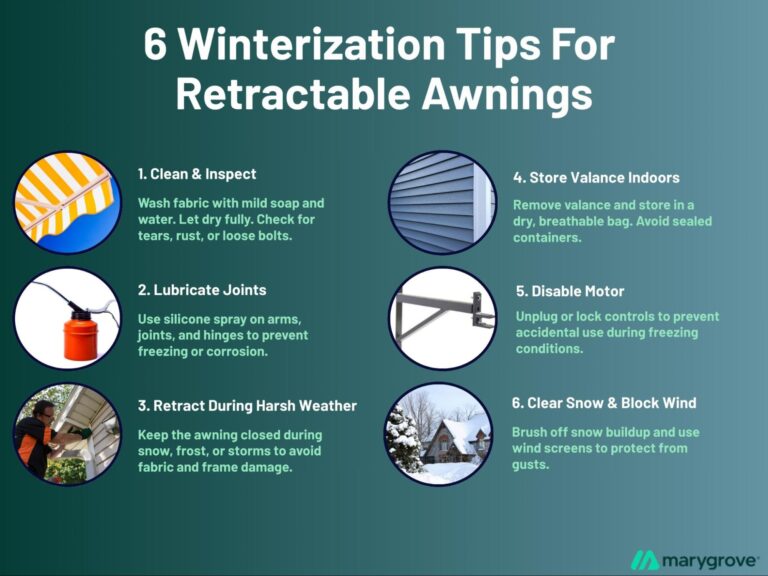
These six tips cover everything you need to do to protect your awning through winter.
They’re simple, effective, and help prevent the kind of cold-weather damage that only shows up when it’s too late.
1. Clean the Fabric and Inspect for Damage
Start with a full surface clean using mild soap, warm water, and a soft brush.
Once dry, inspect the fabric, seams, and hardware for wear. Fixing small tears, rust, or loose bolts now prevents bigger problems later.
Explore Marygrove Fabric & Frames
2. Lubricate Hinges, Arms, and Joints
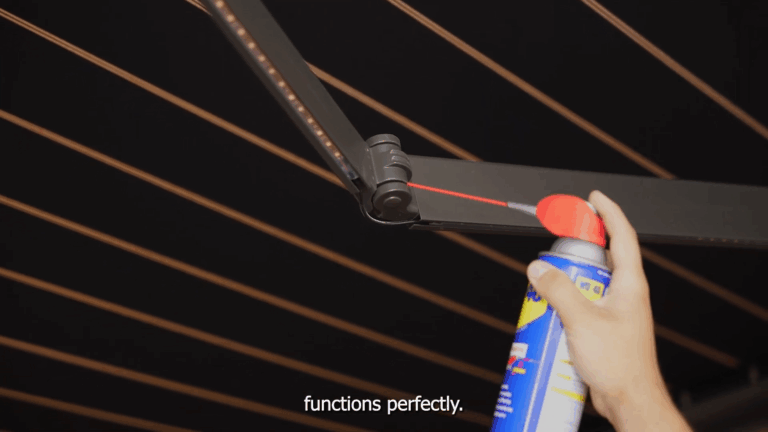
Apply silicone-based lubricant to all moving parts before temperatures drop.
This keeps hinges and joints from freezing or seizing up, especially when moisture and cold work against exposed hardware.
3. Retract the Awning During Harsh Weather
Always retract your awning before storms, snow, or freezing temperatures.
Keeping it closed limits exposure to wind, moisture, and snow weight that can strain or damage the frame and fabric.
4. Manage Wind and Snow Around the Awning
Use wind sensors or build a temporary wind barrier with vinyl panels and Z-channels for extra protection. Regularly brush off snow from the housing to prevent buildup and reduce pressure on brackets and joints.
5. Disable the Motor or Lock the Controls
If your awning is motorized, unplug it or activate the lockout setting.
This prevents accidental use during freezing conditions when the fabric might be stiff or the motor under too much stress.
6. Remove the Valance and Store It Properly
Detach the valance and store it in a breathable, dry space, not in a sealed plastic bin. This prevents stretching, sagging, and trapped moisture that can weaken fabric or cause mold over time.
Even with a fully winterized setup, your awning doesn’t have to sit unused all season. With the right conditions and a few smart habits, you can still get plenty of use out of it.
Here’s how to enjoy it safely during winter.
How to Use Your Awning Safely During Winter
Retractable Awning Installation In the Snow
Winterizing your awning doesn’t mean you can’t enjoy it at all during the colder months.
In fact, with the right precautions, many homeowners continue to get value from their awnings through late fall and even winter.
Whether it’s sipping coffee under a quiet snowfall or hosting a cozy outdoor dinner with space heaters, your awning can help keep the chill manageable when the timing is right.
Here are five safe, effective ways to use your awning during the off-season:
1. Only Use on Mild, Dry Days
If temperatures are above freezing and there’s no wind or snow in the forecast, it’s generally safe to open your awning for a few hours.
Just be sure to close it well before conditions change.
2. Never Operate When Frozen
Before using your awning, check for frost or ice buildup.
If the fabric or arms feel stiff or frozen, avoid opening it. Forcing the system can cause serious damage to motors and joints.
3. Use It for Wind and Snow Buffering
Some homeowners create a semi-enclosed space beneath their awning using removable vinyl or mesh panels.
This blocks wind and light snow, making patios more usable without leaving the awning exposed to direct weather.
4. Clear Off Any Snow Immediately
If snow collects on the retracted awning’s cassette or cover, brush it off before it freezes. Built-up snow adds weight and moisture that can damage internal parts or lead to corrosion.
5. Monitor the Forecast
Keep a close eye on temperature drops, snowfall, and wind. The key to safe winter use is knowing when to enjoy your awning, and when to keep it tucked away.
Enjoying your awning in winter is possible, but only when paired with the right care. Without proper prep, even a single cold snap can leave lasting damage.
But when protected correctly, your awning can turn a back deck into a functional winter lounge, perfect for hot cocoa nights, holiday hangouts, or simply staying connected to your outdoor space.
That’s why programs like the Marygrove Mint Program exist, to handle seasonal maintenance for you and make sure your awning stays protected, no matter the weather.
Let’s look at what can go wrong if winterization is skipped.
What Can Go Wrong If You Skip Winterizing?
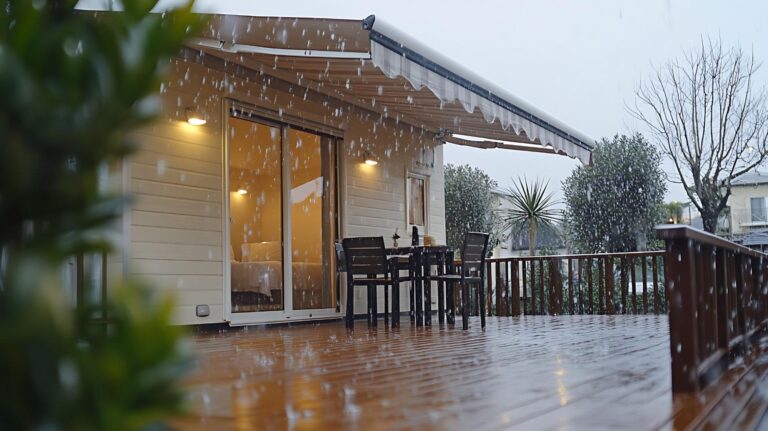
It’s tempting to leave your awning alone through winter and hope for the best.
But skipping winter prep can lead to damage that’s expensive, frustrating, and often hidden until it’s too late. Here’s what can go wrong:
1. Frozen Motors and Broken Arms
When temperatures drop, motors and joints can freeze in place.
If you try to open the awning while it’s frozen, internal gears can snap or arms can twist, leading to major damage or complete system failure before spring even arrives.
2. Mold and Mildew Growth
Retracting your awning while it’s damp traps moisture deep in the fabric folds.
Over the winter, that moisture breeds mildew and mold, which often goes unnoticed until spring when black stains and a musty odor suddenly appear.
3. Permanent Fabric Damage
Fabric that’s left exposed to freeze-thaw cycles becomes stiff, brittle, and more prone to cracking.
Over time, this can lead to permanent warping or splitting, especially in lower-quality models that aren’t built for cold-weather durability.
4. Snow Load Collapse
If the awning is left extended during a snowfall, even a few inches of snow can add dangerous weight.
This extra load puts pressure on the frame and can cause arms to bend, brackets to pull out, or the entire system to collapse.
5. Wind Tearing and Frame Stress
Partially extended awnings are highly vulnerable to wind.
Winter gusts can catch the fabric like a sail, yanking on joints, bending support arms, or even ripping the mounting hardware right out of the wall or soffit.
6. Voided Manufacturer Warranties
Most awning warranties don’t cover damage caused by improper seasonal use.
That includes failing to retract during storms, skipping winter prep, or leaving the unit exposed to snow and ice without a proper cover or protection plan.
Messy DIY Fixes That Backfire
DIY solutions like plywood panels or plastic wrap often create more problems than they solve.
These setups trap moisture, yellow in the cold, and make outdoor spaces look cluttered or unfinished when spring rolls around.
Skipping winterization might seem harmless in the moment, but the damage it causes often shows up when it’s too late to fix.
A little prep now saves a lot of hassle, and expense, down the road.
Final Thoughts on Protecting Your Awning This Winter
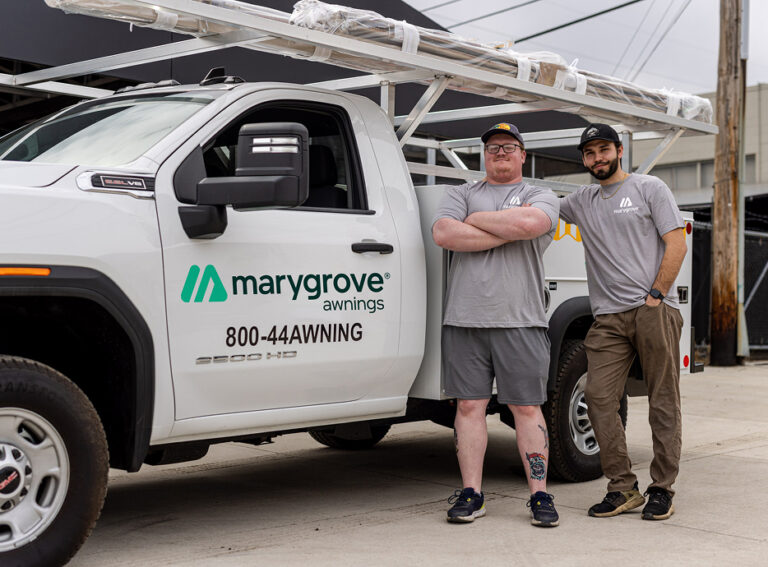
Winter doesn’t have to mean retiring your awning for the season.
With the right precautions, cleaning, inspecting, retracting, and covering, you can enjoy peace of mind knowing your awning is safe, functional, and ready when spring returns.
Taking a few preventative steps now protects your investment and prevents the costly, hidden damage that shows up after months of exposure.
If your current awning feels limited by seasonal challenges, it might be time to upgrade.
Marygrove Awnings are built to handle changing weather with durable materials, smart features, and year-round support.
Whether you’re winterizing or still using your awning on milder days, our systems are designed to perform.
Explore our products or speak with a team member to see how Marygrove can help you stay protected, no matter the season.
